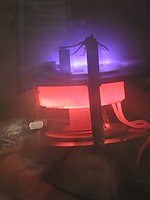
Photo from wikipedia
Two types of chitosan framework materials were functionalized with carboxyl groups via a supramolecular cross-linking process by citric acid (CA) and trimesic acid (TMA). The role of surface chemistry (i.e.,… Click to show full abstract
Two types of chitosan framework materials were functionalized with carboxyl groups via a supramolecular cross-linking process by citric acid (CA) and trimesic acid (TMA). The role of surface chemistry (i.e., functional groups) and textural properties (i.e., pore size and surface area) in adsorption properties of these chitosan frameworks toward water vapor and dye was investigated. Extensive characterizations using N2 adsorption–desorption, contact angle measurements, differential scanning calorimetry, atomic force microscopy, and confocal microscopy were carried out to understand structure–property relationships of these framework materials. The dynamic vapor sorption analyzer measured water vapor sorption percentage (R %) values of 46.7, 43.9, and 41.5 for TMA1, CA1 framework materials, and chitosan, respectively. The calculated adsorption percentage values of dyes in aqueous solution were 69.7, 39.2, and 18.8 (R %) for TMA1, CA1, and chitosan, respectively.
Journal Title: ACS Omega
Year Published: 2020
Link to full text (if available)
Share on Social Media: Sign Up to like & get
recommendations!